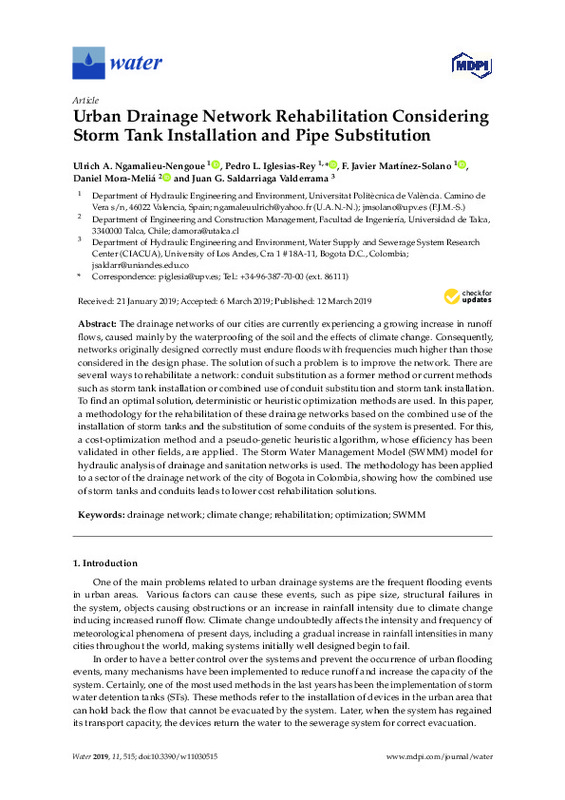JavaScript is disabled for your browser. Some features of this site may not work without it.
Buscar en RiuNet
Listar
Mi cuenta
Estadísticas
Ayuda RiuNet
Admin. UPV
Urban Drainage Network Rehabilitation Considering Storm Tank Installation and Pipe Substitution
Mostrar el registro sencillo del ítem
Ficheros en el ítem
| dc.contributor.author | Ngamalieu-Nengoue, Ulrich Aurele
|
es_ES |
| dc.contributor.author | Iglesias Rey, Pedro Luís
|
es_ES |
| dc.contributor.author | Martínez-Solano, F. Javier
|
es_ES |
| dc.contributor.author | Mora-Meliá, Daniel
|
es_ES |
| dc.contributor.author | Saldarriaga, Juan
|
es_ES |
| dc.date.accessioned | 2020-04-24T07:14:08Z | |
| dc.date.available | 2020-04-24T07:14:08Z | |
| dc.date.issued | 2019 | es_ES |
| dc.identifier.issn | 2073-4441 | es_ES |
| dc.identifier.uri | http://hdl.handle.net/10251/141453 | |
| dc.description.abstract | [EN] The drainage networks of our cities are currently experiencing a growing increase in runoff flows, caused mainly by the waterproofing of the soil and the effects of climate change. Consequently, networks originally designed correctly must endure floods with frequencies much higher than those considered in the design phase. The solution of such a problem is to improve the network. There are several ways to rehabilitate a network: conduit substitution as a former method or current methods such as storm tank installation or combined use of conduit substitution and storm tank installation. To find an optimal solution, deterministic or heuristic optimization methods are used. In this paper, a methodology for the rehabilitation of these drainage networks based on the combined use of the installation of storm tanks and the substitution of some conduits of the system is presented. For this, a cost-optimization method and a pseudo-genetic heuristic algorithm, whose efficiency has been validated in other fields, are applied. The Storm Water Management Model (SWMM) model for hydraulic analysis of drainage and sanitation networks is used. The methodology has been applied to a sector of the drainage network of the city of Bogota in Colombia, showing how the combined use of storm tanks and conduits leads to lower cost rehabilitation solutions. | es_ES |
| dc.description.sponsorship | This work was supported by the Program Fondecyt Regular (Project 1180660) of the Comision Nacional de Investigación Científica y Tecnológica (Conicyt), Chile. | |
| dc.language | Inglés | es_ES |
| dc.publisher | MDPI AG | es_ES |
| dc.relation.ispartof | Water | es_ES |
| dc.rights | Reconocimiento (by) | es_ES |
| dc.subject | Drainage network | es_ES |
| dc.subject | Climate change | es_ES |
| dc.subject | Rehabilitation | es_ES |
| dc.subject | Optimization | es_ES |
| dc.subject | SWMM | es_ES |
| dc.subject.classification | MECANICA DE FLUIDOS | es_ES |
| dc.title | Urban Drainage Network Rehabilitation Considering Storm Tank Installation and Pipe Substitution | es_ES |
| dc.type | Artículo | es_ES |
| dc.identifier.doi | 10.3390/w11030515 | es_ES |
| dc.relation.projectID | info:eu-repo/grantAgreement/CONICYT//1180660/ | es_ES |
| dc.rights.accessRights | Abierto | es_ES |
| dc.contributor.affiliation | Universitat Politècnica de València. Departamento de Ingeniería Hidráulica y Medio Ambiente - Departament d'Enginyeria Hidràulica i Medi Ambient | es_ES |
| dc.description.bibliographicCitation | Ngamalieu-Nengoue, UA.; Iglesias Rey, PL.; Martínez-Solano, FJ.; Mora-Meliá, D.; Saldarriaga, J. (2019). Urban Drainage Network Rehabilitation Considering Storm Tank Installation and Pipe Substitution. Water. 11(3):515-537. https://doi.org/10.3390/w11030515 | es_ES |
| dc.description.accrualMethod | S | es_ES |
| dc.relation.publisherversion | https://doi.org/10.3390/w11030515 | es_ES |
| dc.description.upvformatpinicio | 515 | es_ES |
| dc.description.upvformatpfin | 537 | es_ES |
| dc.type.version | info:eu-repo/semantics/publishedVersion | es_ES |
| dc.description.volume | 11 | es_ES |
| dc.description.issue | 3 | es_ES |
| dc.relation.pasarela | S\380550 | es_ES |
| dc.contributor.funder | Comisión Nacional de Investigación Científica y Tecnológica, Chile | es_ES |








